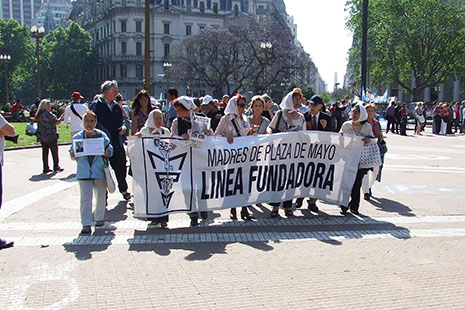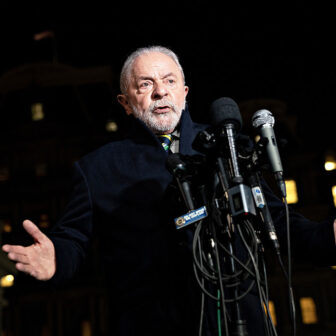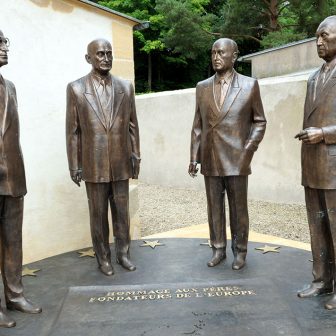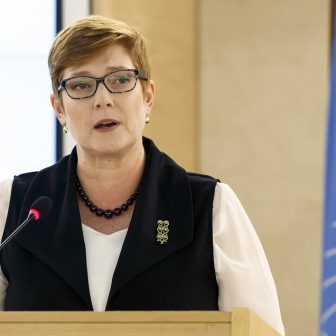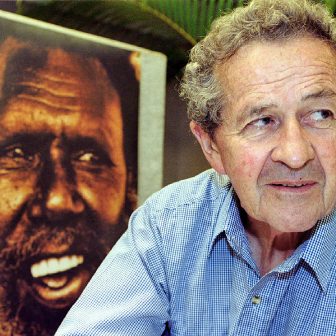IT IS the end of impunity. On 22 April this year, General Reynaldo Bignone – the last Argentinean dictatorial president – was found guilty of fifty-six cases of the kidnapping, torture and murder of political dissidents. At least ten pregnant women were among his victims.
It was a landmark sentence, passed in the context of the megacausa – the epic prosecution of those who committed crimes against humanity during the so-called Dirty War waged by Argentina’s military dictatorship in the 1970s. The megacausa is as massive as its name suggests, made up of more than a thousand lawsuits against those allegedly involved in the murder of more than 30,000 dissidents. Since it began in early 2009 thousands of witnesses have been summoned to testify.
The prosecutions have been clustered around some of the most notorious clandestine detention centres, created by the dictatorship to torture and exterminate political dissidents. The largest trials of the megacausa are related to crimes committed at two locations: the Navy Mechanics School, known as the ESMA, and Campo de Mayo. Both detention centres became symbols of state terrorism and crimes against humanity
General Bignone – who will spend the next twenty-five years of his life in a common cell, in a common jail – was judged and sentenced in the context of the Campo de Mayo megacausa. In 1976, the former dictator was the head of Campo de Mayo garrison. During the Dirty War, it became one of the largest centres for torture and extermination in the country.
Popularly known as el campito (the little camp) and situated twenty-six kilometres to the north-east of the capital, Buenos Aires, Campo de Mayo was one of 339 concentration camps that operated with total impunity. More than 5000 dissidents passed through its gates. Few were seen again. One of them was fifteen-year-old Floreal Avellaneda, known as el negrito (the little dark one).
His was only one murder among many, yet it has convulsed a traumatised nation. A member of the youth faction of the Argentine Communist Party, he was kidnapped on 15 April 1976. He was then taken to Campo de Mayo where he was tortured to death. His badly mutilated body appeared a month later near the neighbouring Uruguayan coast. Another forty cases related to crimes committed in Campo de Mayo are underway.
On September 20, another chapter in the trials will open when the megacausa is expected to examine one of the most disturbing aspects of Argentina’s Dirty War – the cases of children who were born in detention centres and then “adopted” by families associated with the regime. In effect, the children became war booty.
The first to sit in the dock will be former dictator General Rafael Videla, accused of the kidnap of thirty-three babies born in the ESMA to female political prisoners. In April this year his immunity, granted by the notoriously corrupt former President Carlos Menem, was declared unlawful.
The ESMA, like several other detention camps, had a “maternity ward” where women political prisoners gave birth. In most cases, these women were kept barely alive – while undergoing medically supervised torture – until the children were born. Execution soon followed and the children were given away. Many of those who adopted them were members of the armed forces or families who were close collaborators with the military regime.
The idea of stealing children from murdered political dissidents appears to have been inspired by the Spanish dictator, General Franco. During his rule, thousands of recently born children were stolen from mothers – mainly political dissidents – to be “re-socialised” in orphanages created specially for this end.
During Argentina’s Dirty War 500 babies were taken from their mothers in this way, according to human rights organisations. The Grandmothers of the Plaza de Mayo have tracked down 240 of these children and approximately 100 have recovered their identity. Most are now in their mid twenties and thirties. Vital to their identification has been the National Genetic Data Bank, created in 1987 to catalogue the DNA from families of stolen children. The bank contains blood samples given by families of thousands of people who were tortured and murdered.
Recently, the search for the stolen children received a major boost with the passing of a law that will allow DNA samples to be taken compulsorily from anybody who might be considered the child of a missing person. The Grandmothers of the Plaza de Mayo – who have been instrumental in pushing for this legislation – found an important ally in President Cristina Fernández, who said, “To recover a grandchild is a victory for the rule of law.”
The case has already implicated a leading member of Argentine high society. Ernestina Herrera de Noble is the owner of Clarin, Argentina’s largest media conglomerate group, whose financial might owes much to the generosity of General Videla. Human rights groups – including the Grandmothers of the Plaza de Mayo – insist that Herrera de Noble illegally adopted her two children, who the Gransmothers claim were born thirty-four years ago in the camps.
Argentina’s megacausa permeates the country, from imposing palaces of justice in Buenos Aires to humble provincial courtrooms. With so many cases, even municipal gymnasiums have been co-opted as courtrooms. It was in one such sports hall – the Polideportivo Municipal Florida Oeste – that the Federal Criminal Oral Tribunal No 1 of San Martin passed the sentence on General Reynaldo Bignone.
I was there last November when Bignone and six other officers arrived for the first day of the trial. I remember him well – his intense, small eyes and air of invulnerability, or perhaps superiority, contrasted dramatically with the uncertainty in the faces of the victims’ families, who each day dutifully filled the corners of the Polideportivo. It was not for another six months, when General Bignone’s sentence was passed, that these families knew that, finally, justice had been done. “Justice came late, but it came,” said Estela de Carlotto, the tireless leader of the Grandmothers of the Plaza de Mayo.
Military dictators are prone to grandiloquence and Argentina’s dictators were no exception to the rule. They called the brutal dictatorship the “National Reorganisation Process.” In reality, it was a slaughter. The “process” transformed Argentina into a terrorist state that installed in the imagination of its citizens a nightmarish figure – el desaparecido, the missing one. Missing people don’t exist, they have no entity, they are not present, the perpetrators used to claim. The “missing one” was a strategy of impunity. It was expected that the “unfound body” would prevent the family of victims from taking legal action. No body found, no crime committed.
The strategy eventually failed, though. In the past few years, hundreds of bodies have been found and their identities determined. The Argentinean Team of Forensic Anthropology has played a critical role, painstakingly unearthing anonymous graves in clandestine cemeteries and identifying thousands of victims of the military’s madness.
Since the beginning of the megacausa, 114 military officers have been convicted. A major triumph for justice, these trials for crimes against humanity would not have been possible without the landmark decision in 2003 declaring unconstitutional the Law of Due Obedience, also known as the Law of Full Stop.
This law was passed in 1987 by President Raúl Alfonsín who, as the first post-junta elected leader, had to tread cautiously on the road to democracy amid fears of a regression to military rule. The Law of Full Stop meant that hundreds of perpetrators have been left unpunished. Many of them have enjoyed peaceful deaths surrounded by loved ones, others have gone mad, and yet more have escaped to foreign countries. In the meantime many key witnesses and survivors have died awaiting justice.
Since the end to impunity in 2003, around 1500 people – including civilians who collaborated with the military rulers – have been investigated for crimes against humanity. Now they are filling the docks of the megacausa courtrooms. Some voices have been heard calling the government to end these trials – the hierarchy of the Catholic Church, for example, has claimed that the trials are not conducive to reconciliation – but President Fernández has, to her credit, pushed ahead.
President Fernández’s determination is in marked contrast with other Latin American leaders who have opted for impunity rather than justice. This is the case – surprisingly – with Brazil’s president, Luiz Inácio Lula de Silva. President Lula de Silva supported a ruling by Brazil’s Supreme Court last April, which ratified the Law of Amnesty granting impunity for human rights violations committed during the 1964–85 military dictatorship.
FOR THE victims’ families, the trials seem to be taking place in slow motion. “If the trials do not speed up, the justice system will take three decades in judging all the accused people,” says Gonzalo Conte, from the organisation Memoria Abierta (Open Memory). Indeed, at the current pace, the litigation will end in 2030.
During this sluggish process, a dozen perpetrators – mainly aging men – have died before they reached the courts. Around another 230 suspects have died while under investigation, according to the Buenos Aires–based Centre for Legal and Social Studies. The situation has prompted the UN Human Rights Commission to support Argentine human rights activists and families of victims in demanding that judges “be more expeditious when dealing with crimes against humanity.”
Accusing fingers have pointed straight at the judicial system: many of the judges lack expertise and – in a sign of what is seen by many as the judiciary’s complicity in the mechanism of murder – they have shown a complete lack of will to investigate human rights abuses. According to the respected Página/12 newspaper, several judges are under investigation for human rights abuses committed during the dictatorship.
The judiciary’s reticence has, however, been swamped by the ceaseless clamour of the ageing voices of the Grandmothers of the Plaza de Mayo and a counterpart organisation, the Mothers of the Plaza de Mayo. The megacausa is no doubt one of their greatest accomplishments.
From the withered gardens of the Plaza de Mayo – the square just across from the presidential palace in Buenos Aires – the Mothers and Grandmothers have never allowed Argentina’s mass murders to be forgotten or forgiven. Covering their heads with their iconic white headscarves on which the names of their loved ones have been embroidered, these women are universal symbols of human rights defence. For more than thirty years, they have gripped handmade placards with worn-out black and white photographs of their sons, daughters, husbands and wives: missing ones who have not been forgotten.
The Mothers and Grandmothers’ moving and uncompromising demand, Los desaparecidos, que digan donde están! – The missing ones, tell us where they are! – is now heard in each courtroom in which the megacausa is unfolding.
LAST YEAR, on a warm day in early December, I saw these women walking towards a courtroom with their placards, heading to the first day of the ESMA megacausa where nineteen members of the armed forces were being tried for crimes against humanity. At noon, two hours later than scheduled, the nineteen handcuffed defendants entered court to face charges relating to the torture, disappearance and murder of eighty-six people. More than 300 witnesses had been summoned to testify.
It is estimated that 5000 people passed through the ESMA. Fewer than 200 survived. One survivor was Enrique Fukman, who is now a member of the Association of Former Detainees and Missing People. “I was kidnapped on a Saturday at midday,” he remembers. He was thrown into a car and the interrogation and torments began immediately. “I played ignorant and they started burning me with cigarettes.” Fukman – whose voice is firm and calm – was driven to the ESMA. Handcuffed and blindfolded he was taken to the basement. He was stripped and tied naked to a metallic mattress where he was tortured with an electric prod. “It was my welcome to the ESMA,” he says.
The ESMA was one of the five largest centres that became the axis of state terrorism. Each had a benign name that hid the horror: the Athletic Club in the city of Buenos Aires; Campo de Mayo; the Perla (the Pearl) in Córdoba and the Vesubio. In the Vesubio a sign hung at the entry to the torture chamber: si lo sabe cante, si no aguante (if you know it, sing it; otherwise bear the pain).
Located on the north side of Buenos Aires, the ESMA is now a commemorative museum. I walked through its corridors, through the canteen and down to the basement. There, at the end, were chambers 12, 13 and 14 where the trip to hell began. Days, weeks and months of brutality.
Some of the emblematic cases are being heard in the ESMA megacausa. One is the case of writer and journalist Rodolfo Walsh. After writing a critical letter to the military junta in 1976 Walsh was kidnapped; he was last seen alive in the ESMA. Others cases include the disappearance of three founding members of the Mothers of the Plaza de Mayo – Azucena Villaflor, María Ponce and Esther Ballestrino – and the murder of French Catholic nuns Alice Domon and Leonie Douquet, whose bodies were found in a grave marked “NN” (no name) in a cemetery.
The head of the ESMA was Admiral Eduardo Massera, a key figure in the Dirty War. Massera was a member of the first military junta that ruled Argentina following the 1976 coup against President María Estela de Perón. Massera has been charged with torture, murder and the kidnapping of children born while their mothers were in detention. Despite the atrocities, Massera will not face trial. Last March, six doctors determined that he was unfit owing to senile dementia – the same diagnosis claimed by Chile’s dictator, General Augusto Pinochet, who died technically innocent in his own home.
While Massera will not be prosecuted, the ESMA case has brought an important development. Captain Jorge “Tiger” Acosta, one of the key navy staff operating the camp, has admitted that “there were people detained” and that crimes were committed there. He also admitted a major “error” made at the ESMA – “prisoners should not have left alive,” he said.
One of those higher up the chain of command at ESMA was Captain Alfredo Astiz. He was known as the “blond angel of death.” With his Aryan appearance, Astiz looks like a stereotypical character from a Nazi concentration camp. He tortured hundreds of people.
In the 1970s, while in his twenties, Astiz infiltrated the Mothers of the Plaza de Mayo, an action that led to the kidnapping of the organisation’s three founders and the two French Catholic nuns. He is also responsible for the abduction, torture and ultimate murder of a seventeen-year-old Swedish teenager, Dagmar Hagelin.
A sociopath – in an interview he bragged of being “the man best prepared technically to kill politicians and journalists” – Astiz is also a coward. In April 1982, during the Falklands War, he waved the white flag to a small group of British forces without firing even a single bullet. In one of the only photographs showing him facing a real army, a defeated Astiz appears signing his unconditional surrender on board HMS Plymouth.
The ESMA’s brutal campaign had no limits. It was from here that hundreds if not thousands of prisoners were loaded into airplanes to be dropped into the sea or into the Río de la Plata. Most of them were alive, drugged with their hands tied.
Former navy pilot Julio Alberto Poch was one of those identified and charged for the death flights. Arrested in Spain, he was extradited to Argentina last year. Before his arrest, Poch was a pilot of Transavia, a Dutch commercial airline. Since his arrest, work colleagues at the airline have testified that Poch used to brag about his participation in death flights. He is now appearing in court in the ESMA trials.
THE WAVE of justice sweeping across Argentina is not easy to keep up with. Just last month a tribunal in Buenos Aires began hearing cases against those who allegedly staffed Automotores Orletti, a former mechanics garage used during the Dirty War as a base for Operation Condor – the multinational operation of political repression and intelligence activities set up by the military regimes that ruled the Southern Cone of Latin America.
Nicknamed the “Garden,” the former garage was transformed into a centre of systematic torture and killing. It is thought that around 200 political prisoners passed through the place – not only Argentineans but also Chileans, Uruguayans, Paraguayans, Bolivians and Cubans. Six former military and intelligence officers have been charged with the kidnap, torture and murder of 65 people.
The megacausa is not only a trial to punish the perpetrators; it is also about providing the country with an official truth. In a symbolic sense, it is also a reminder of the nunca jamás – the pledge made by the Argentine people that crimes against defenceless men, women and children must never again have to be mourned in their country.
The pledge is a reminder of the words of American journalist Sydney H. Schanberg, who wrote about Cambodia’s genocide: “Painful though it may be to contemplate these accounts of young survivors, they desperately need to be passed, whole and without softening, from generation to generation. For it is only by such bearing of witness that the rest of us are rendered unable to pretend that true evil is exceedingly rare in the world, or worse, is but a figment.”
This year Argentina is celebrating 200 years of independence from Spain but the shadow of the Dirty War’s atrocities hovers over the bicentenary. This is the year of the megacausa, a year when the perpetrators of Argentina’s strategy of mass murder are, one-by-one, being made accountable for their crimes against humanity. More than thirty years have passed since the end of the dictatorship, Argentina’s darkest chapter. It is a chapter that the megacausa – the world's largest series of trial for crimes against humanity – is trying to close once and for all. •
